There is no greater pleasure for us than landing in a country we know little about. The learning curve is steep, the intellectual stimulation high. All our senses kick into higher drive ready to absorb what a new culture has to offer.
And so we land in Sri Lanka, bubbling with enthusiasm about the 360 degree discovery adventure we are about to embark on.
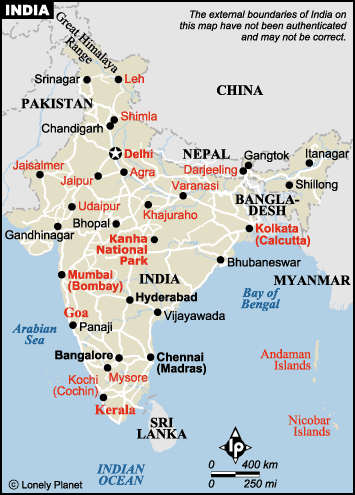 |
| Just to position it… Sri Lanka, on the Eastern point of India… |
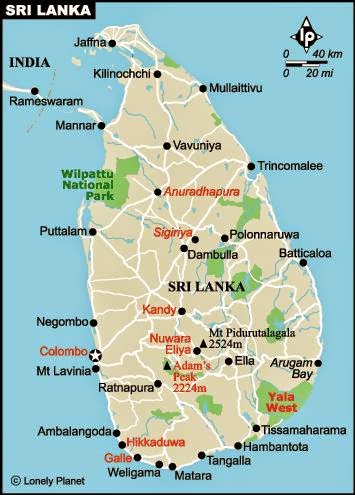 |
| Sri Lanka ~ the “Pearl of the Indian Ocean” |
Why are we in Sri Lanka?
When we buy our tickets to India, the cheapest tickets are on Sri Lankan airlines with a stop-over in Colombo, the Sri Lankan capital. We find out that there is no additional cost to a lengthier stay and without much hesitation we both jump at the opportunity to get acquainted with this small island. Known as the “Pearl of the Indian Ocean”, for its beauty, fertile soil and geo-strategic position at the entrance of the Indian Ocean, Sri Lanka is the size of Nicaragua and smaller than the state of Illinois.
We both start to research and collect ideas of the “what” and the “where”.
Sri Lanka has many National parks, with a large number of elephants in the wild, more than anywhere else in Asia. There is abundant wildlife and a large variety of birds, both local and migratory. This in and of itself is enough to compel us to want to be here. Add lush verdant tea country, gorgeous beaches, ancient temples, and Portuguese Colonial towns… stopping just for a couple of days doesn’t make sense …we want more time!
Ben investigates whether he can carve out a business angle that would justify our staying in country longer… and he finds what he is looking for. We decide to be in Sri Lanka for about 3 weeks, enough time to not rush but rather absorb a few places slowly and get a taste of what Sri Lanka is like. As Sri Lanka is not yet a mainstream tourist hub, we will also use the blog to write about some exceptional and unique Sri Lankan destinations.
The 21 million people who inhabit Sri Lanka are primarily Buddhist, then Hindu, Christian and Muslim. Quite an amalgam of cultures and ethnicities. There are 2 main languages spoken: Tamil and Singhala, i(n addition to English), and 2 beautifully curvy written scripts, (even prettier than Sanskrit.)
Our first day in Colombo starts auspiciously with a Buddhist holiday. Thus we find ourselves at one of Colombo’s main Buddhist temples, Gangaramaya Temple.
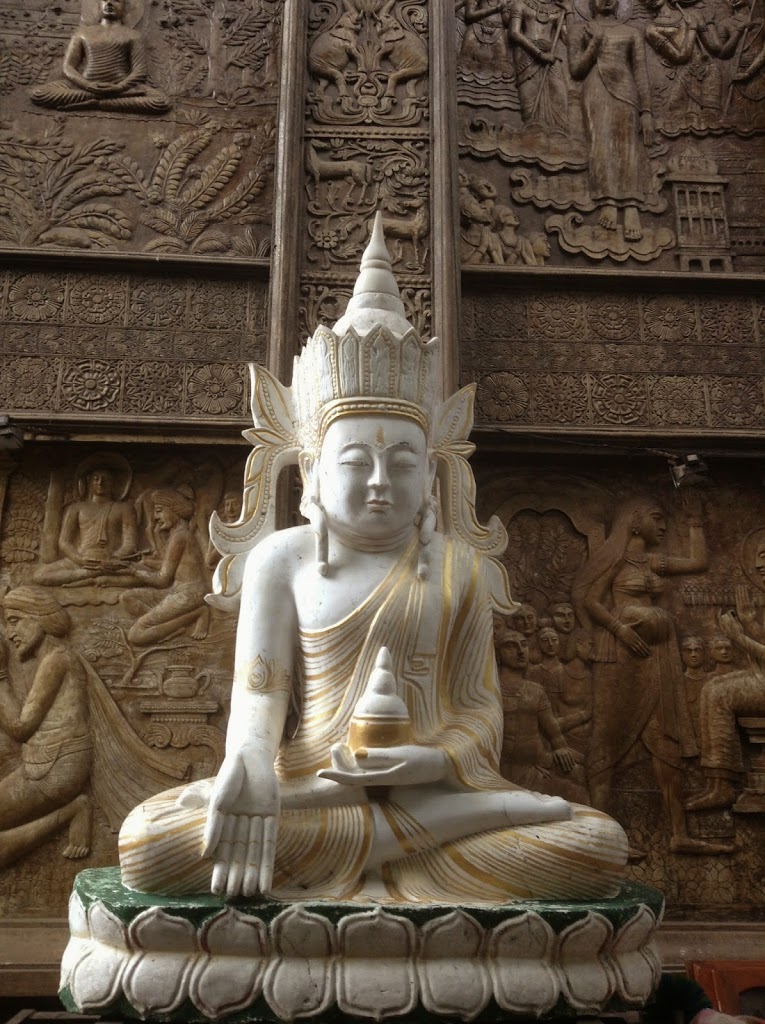 |
| Buddha sculpture indicating the grating of wishes to those who welcome the teachings of Buddhism (right hand points downward with palm facing outward.) |
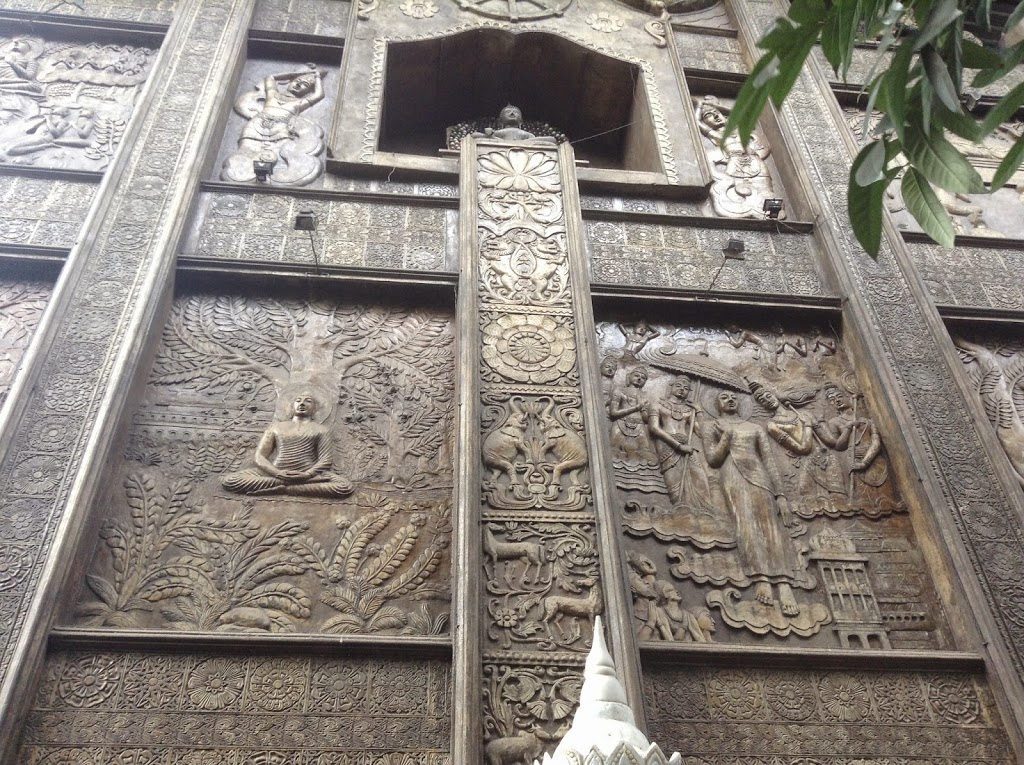 |
| Intricately carved wooden wall with Buddha and animal images. |
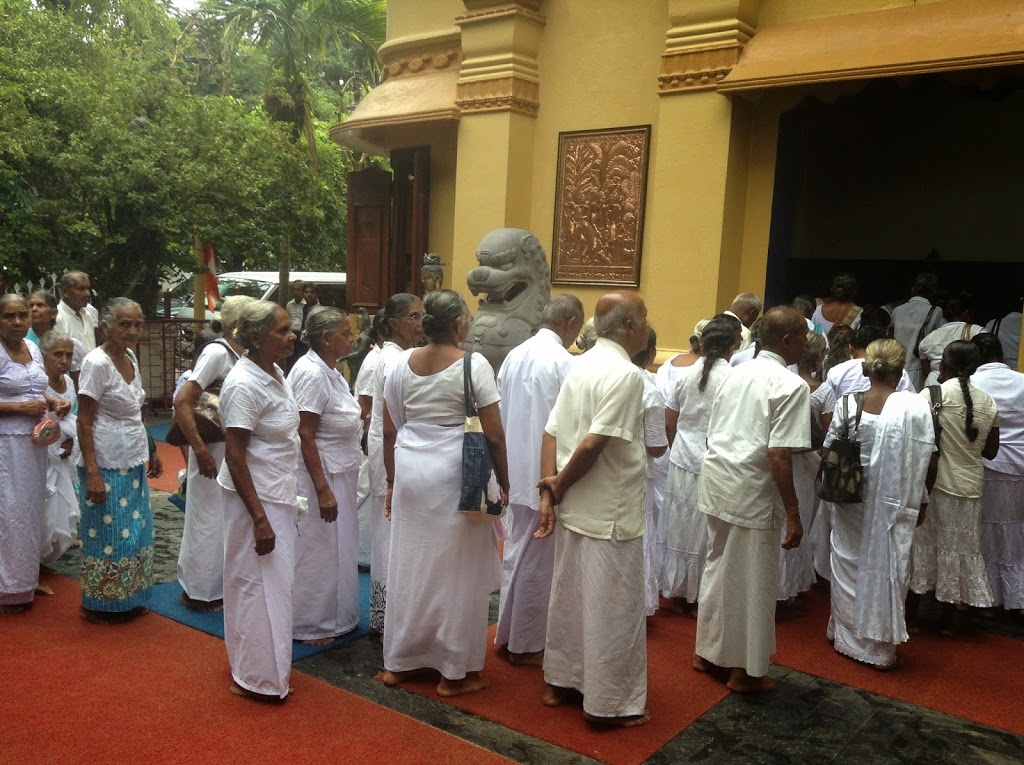 |
| Locals arriving to pay respects at the Buddhist Temple |
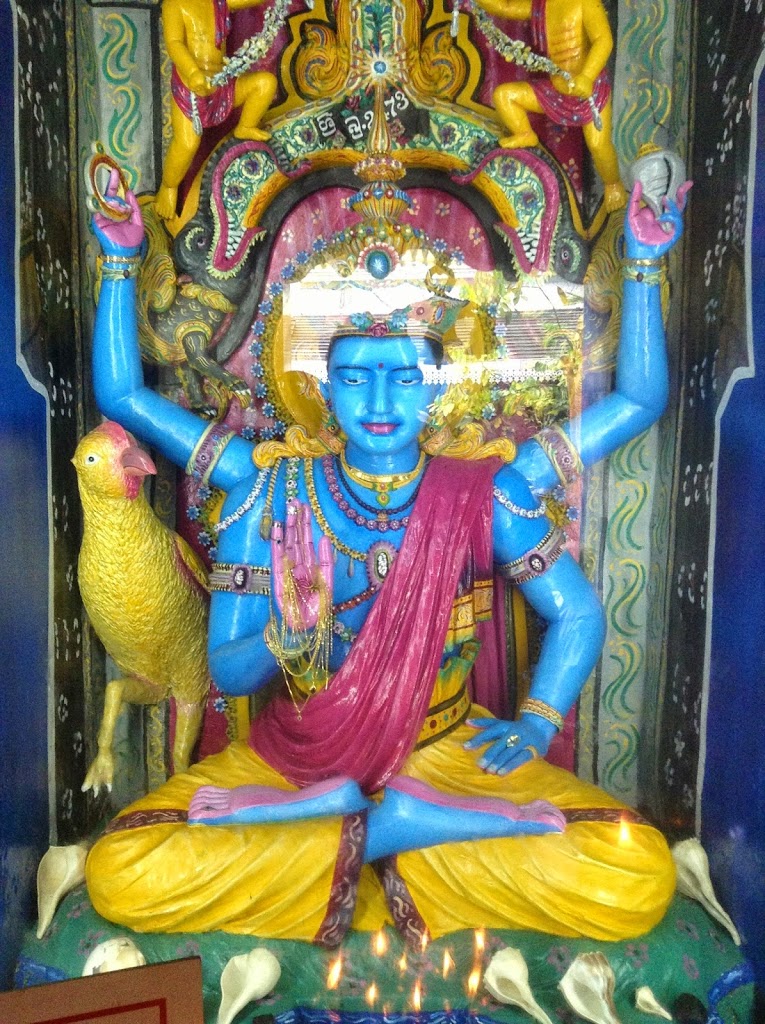 |
| Vishnu sculpture in double lotus position. The four arms represent east, south, west and north and the blue skin is all pervasive like the infinite ocean. |
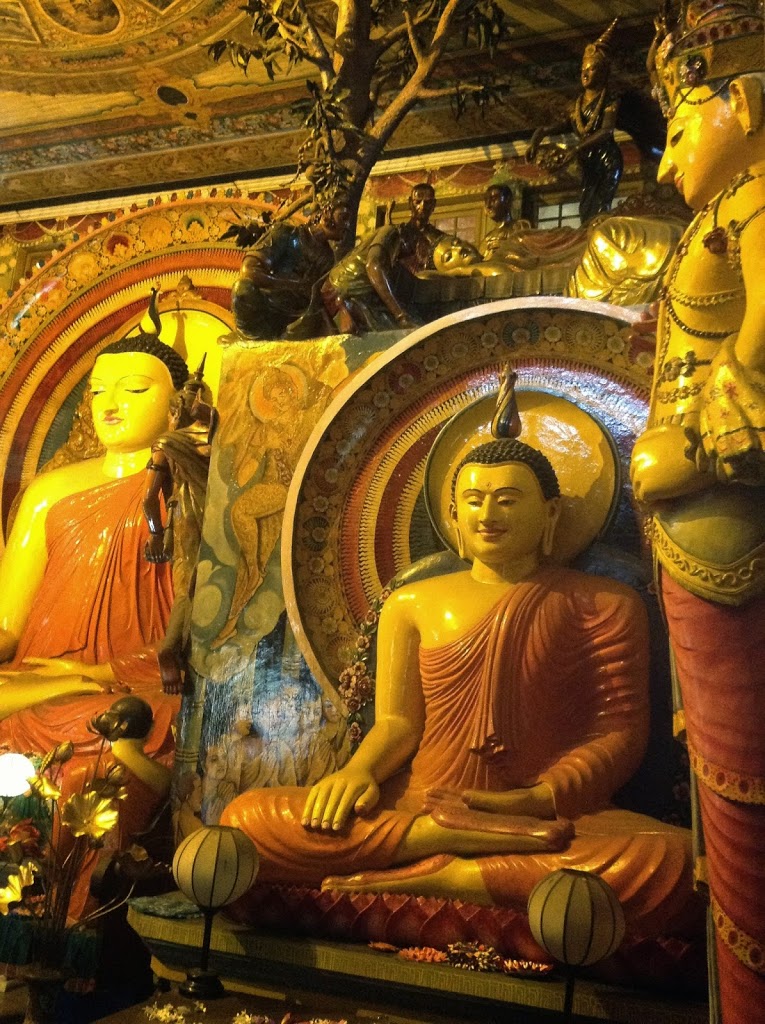 |
| The interior of the temple has numerous very large orange and yellow sculptures of Buddha |
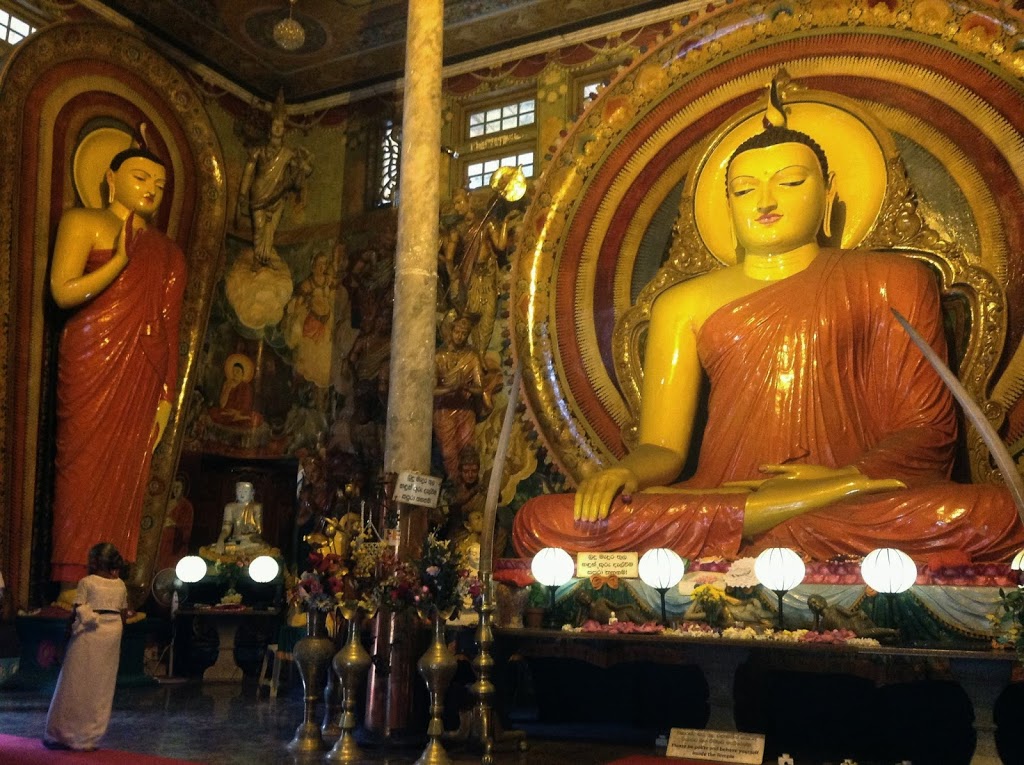 |
| You can get an idea of the size of these sculptures, by looking at the woman on the bottom left hand side. |
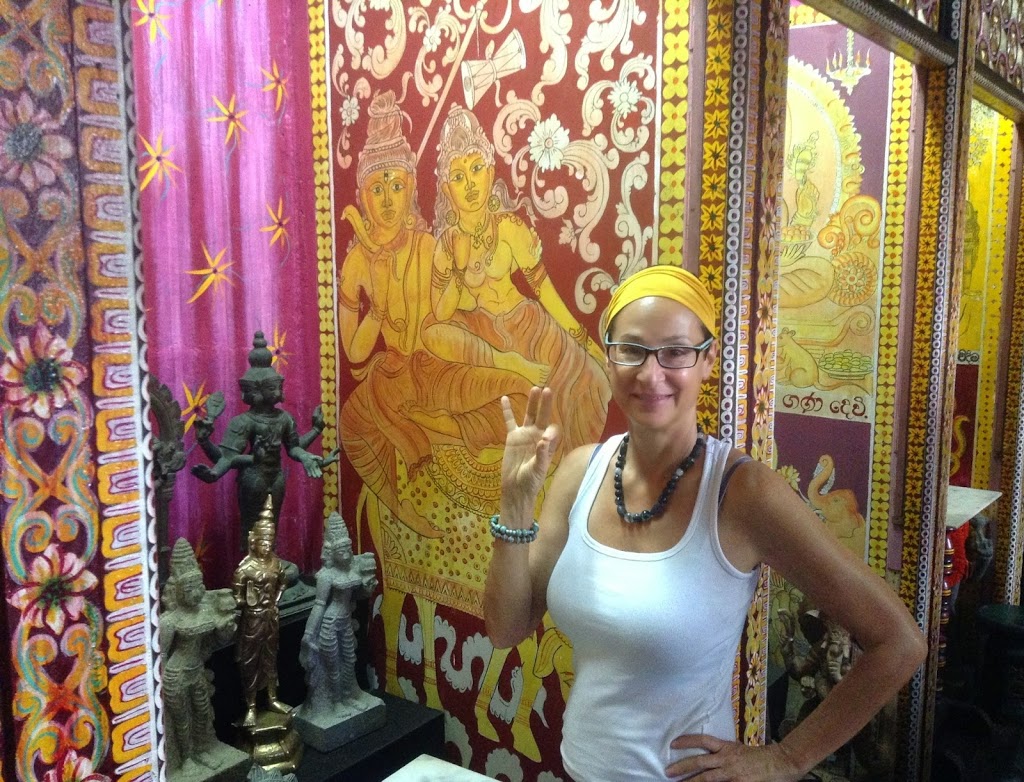 |
| Individual shrine “booths” |
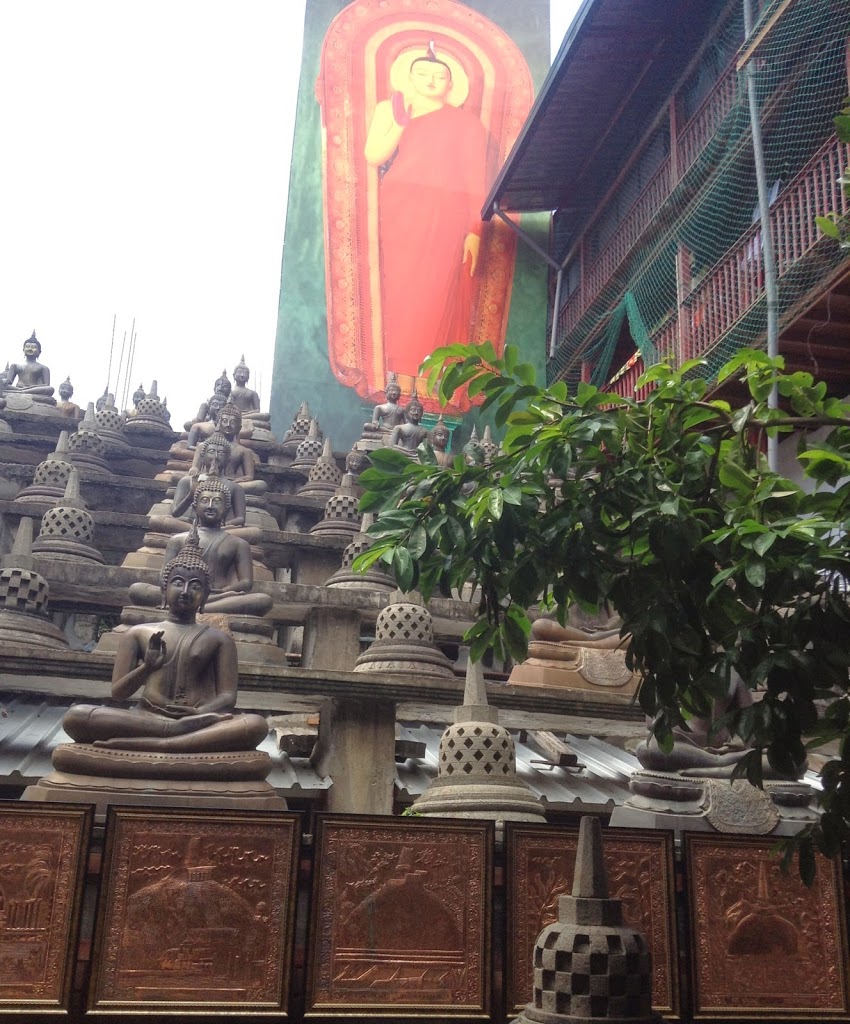 |
| Exterior of temple has rows and rows of Buddha sculptures and small stuppas. |
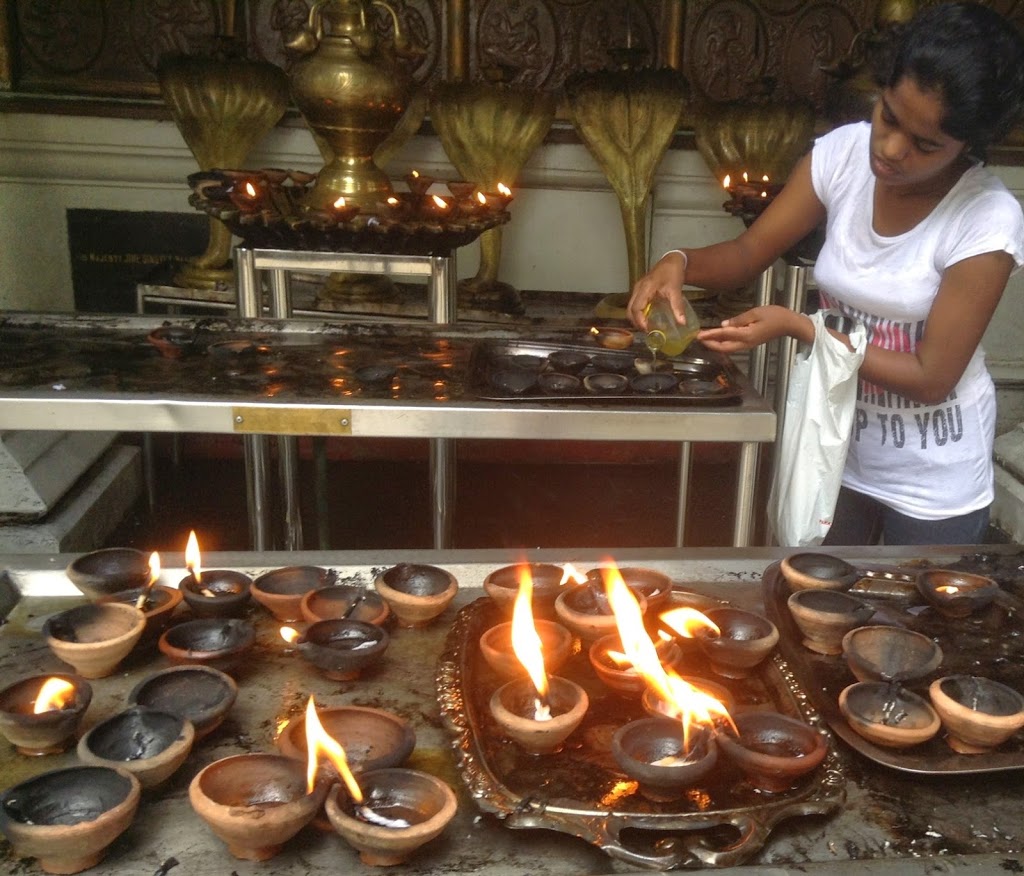 |
| Pouring of oil to light prayer candles |
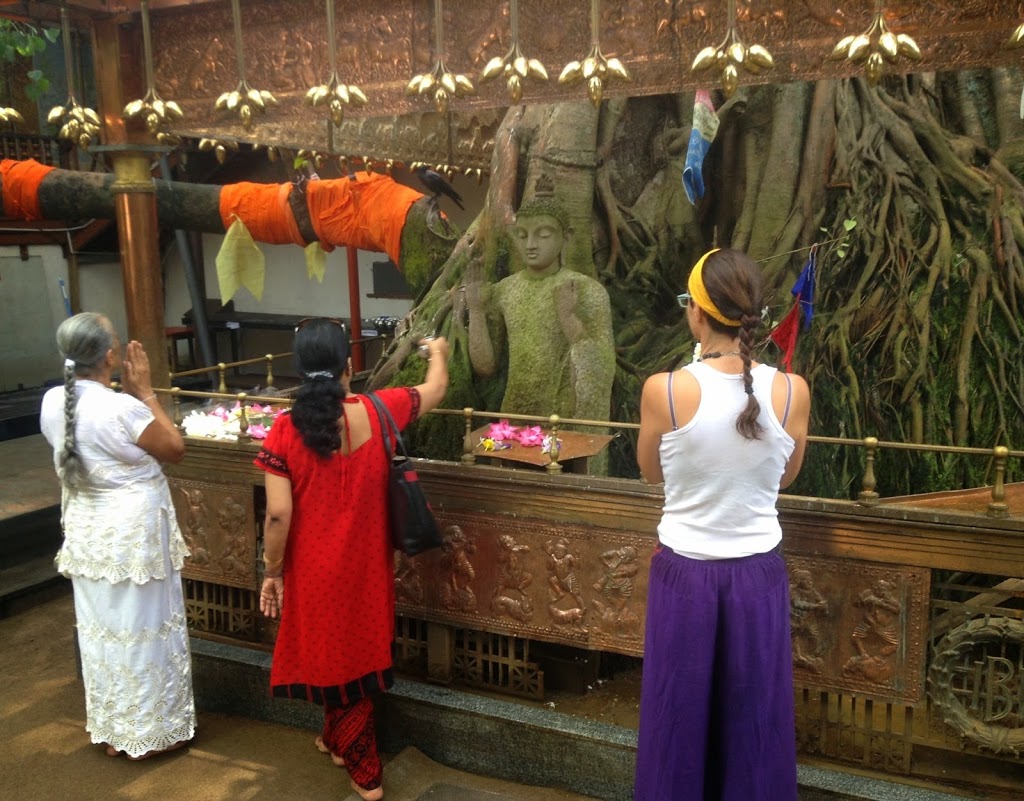 |
| The Bodhi Tree is sacred in Buddhism and protected as well as wrapped in fabrics. The tree gets surrounded by flowers and incense and often dictates the site of temples. |
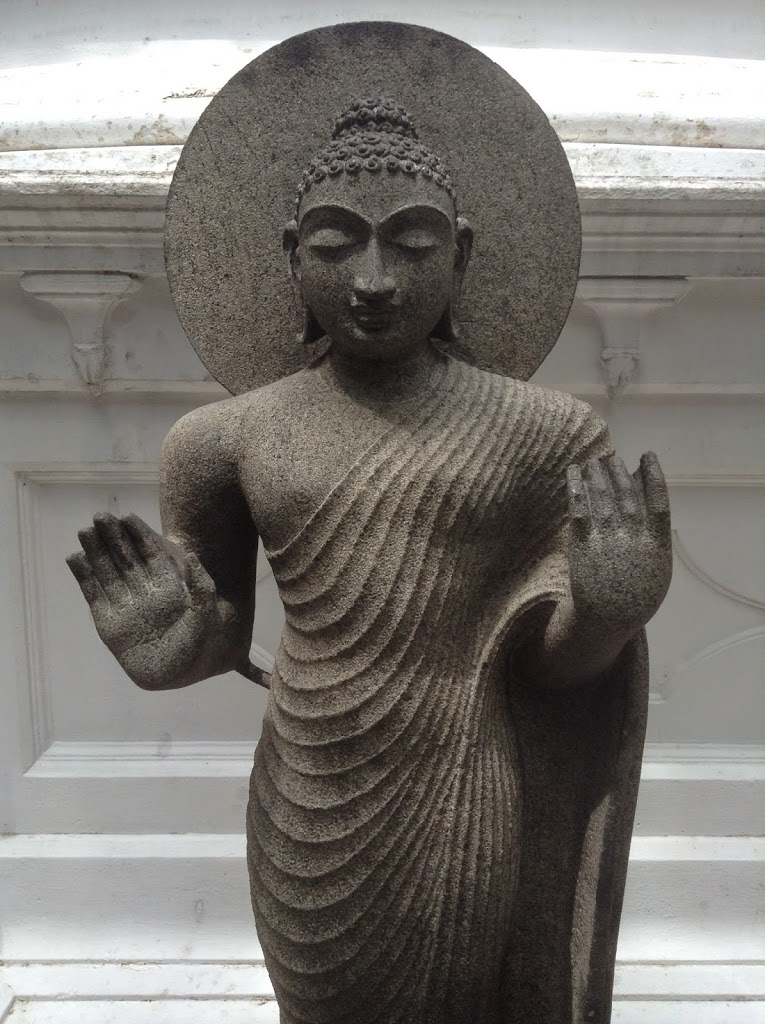 |
| A smaller replica of a very large famous sculpture which is carved out of stone rock in the North of Sri lanka. |
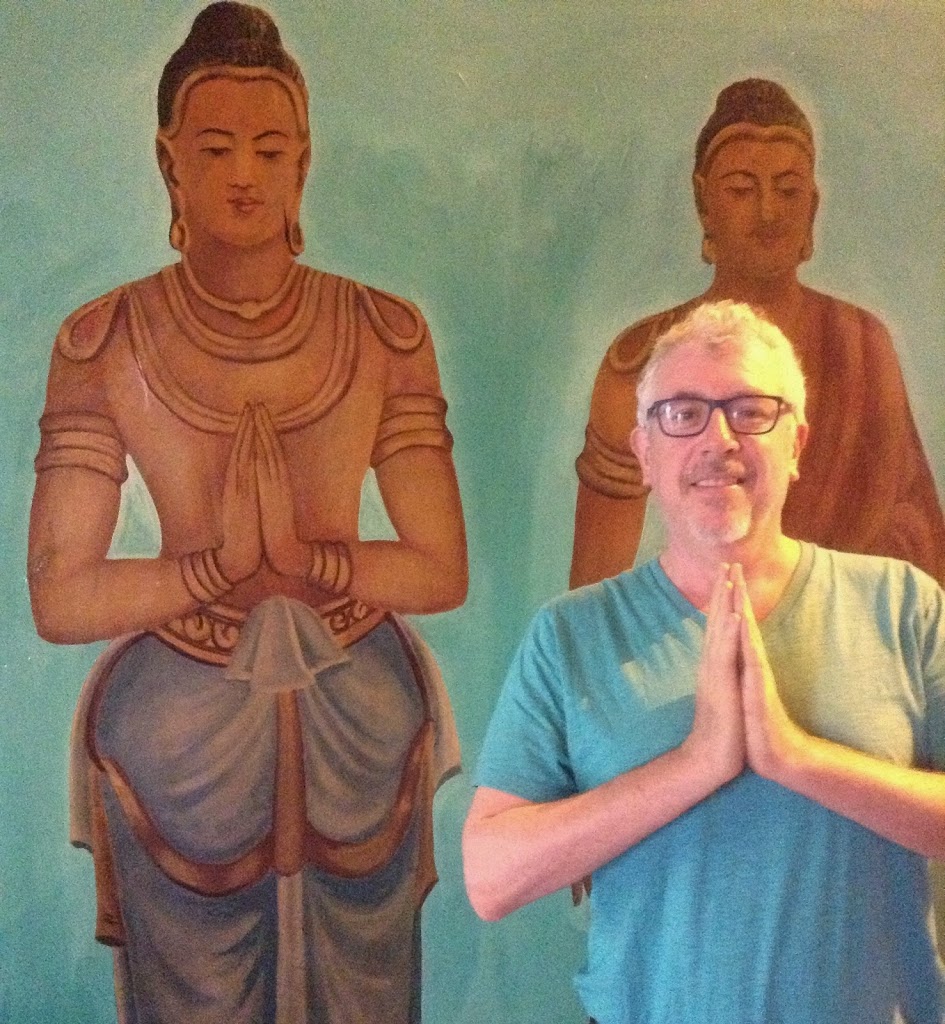
After culture and religion, we go of course to the local market. The wholesale Pettah vegetable market is almost closed, due to the late hour, but we can still get a feel for the activity and basic “vibe”. The market has a mixed population, part Hindu, part Muslim. It is actually very nice to be there at the end of the day, as the shopping frenzy is over and vendors are slowly packing up their huge piles of vegetables after a long day of work.
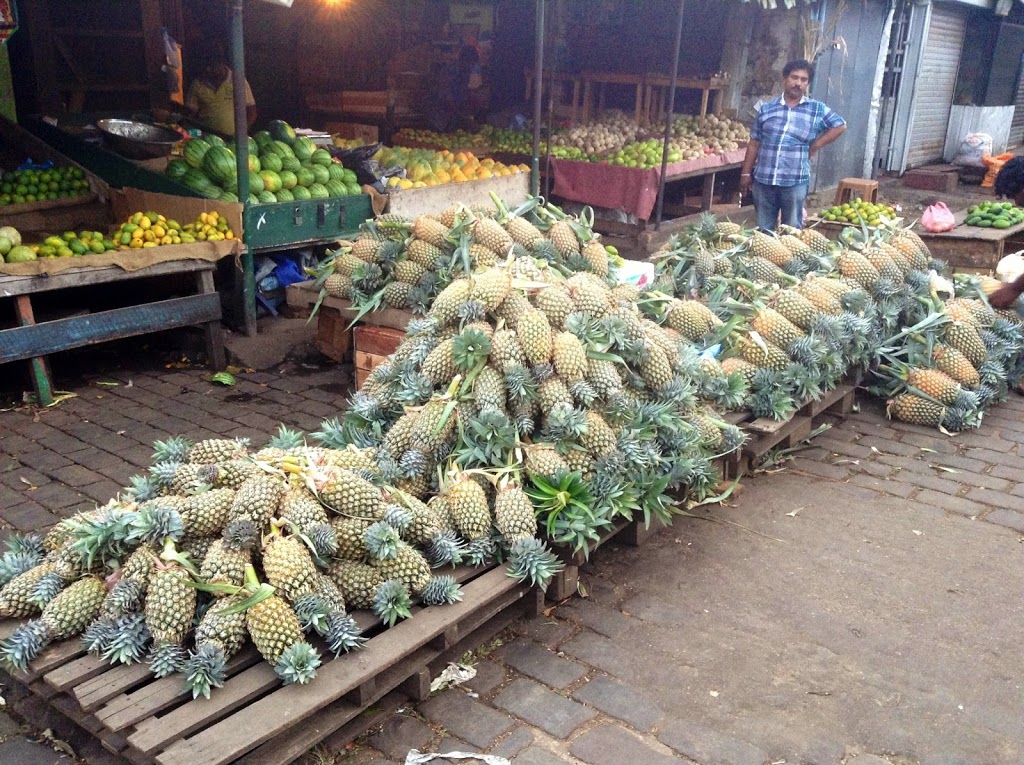 |
| Pineapples galore. They still have a part of the plant attached at the base. |
 |
| A variety of dried cubed smoked fish. |
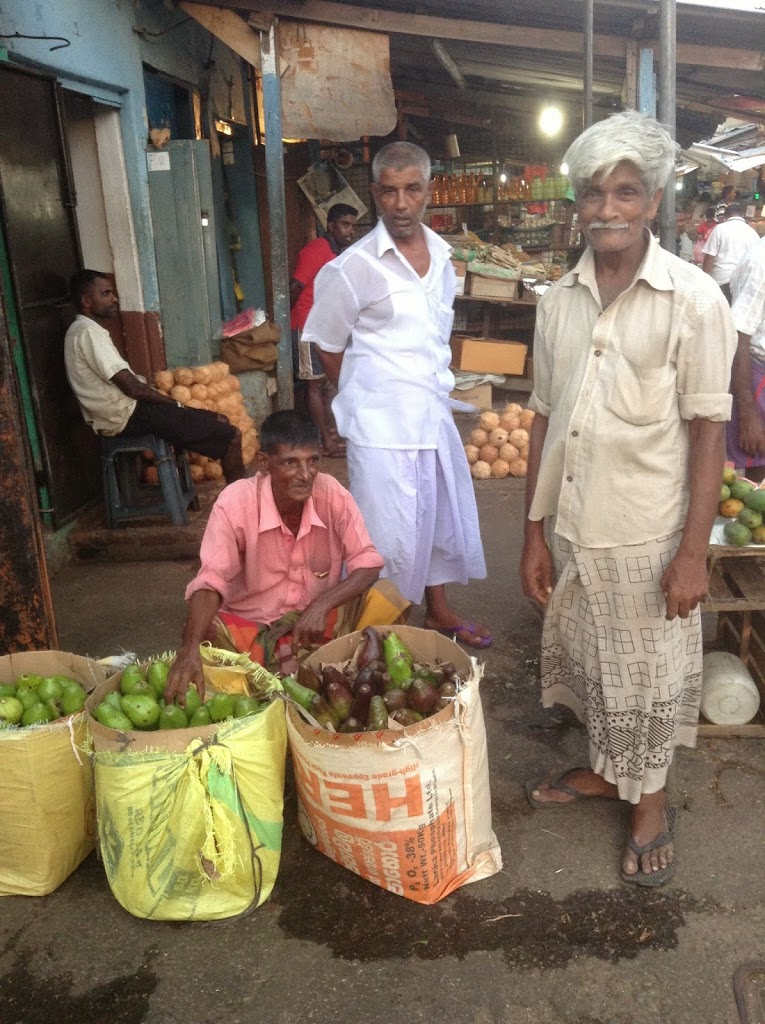 |
| Many Sri Lankan men still wear the traditional clothing ~ sarong like wrap around fabric. |
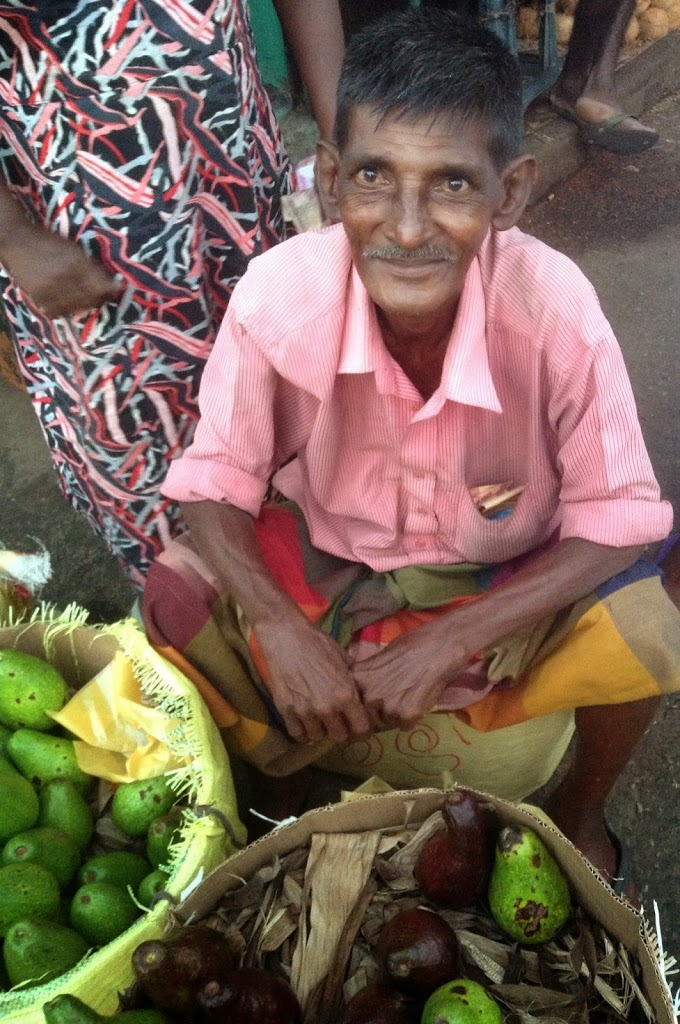 |
| We buy some good avocados from this vendor. |
The Hindu and Muslim communities continue to co-mingle in the early evening, at the beach front, enjoying the warm waters and cool breeze… We love the fact that there is not one other foreigner in sight and we get to mingle and talk to the very friendly locals.
There are families with children flying kites, young men playing drums and dancing and old and young talking and enjoying the end of the day as the sun goes down over Colombo.
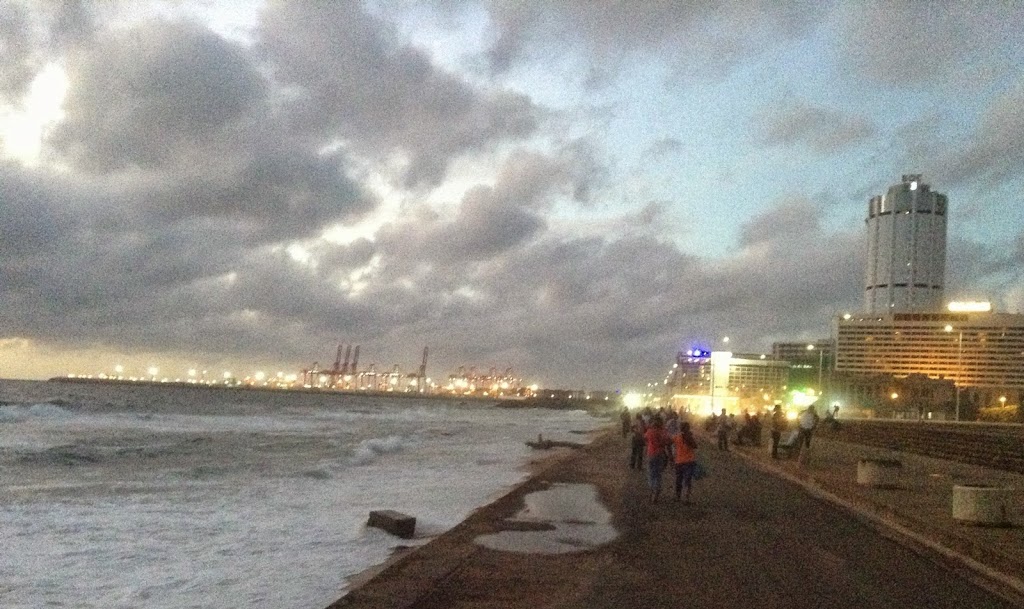 |
| A new boulevard for strolling alongside the sea, in front of the city. The port is on the horizon to the left. |
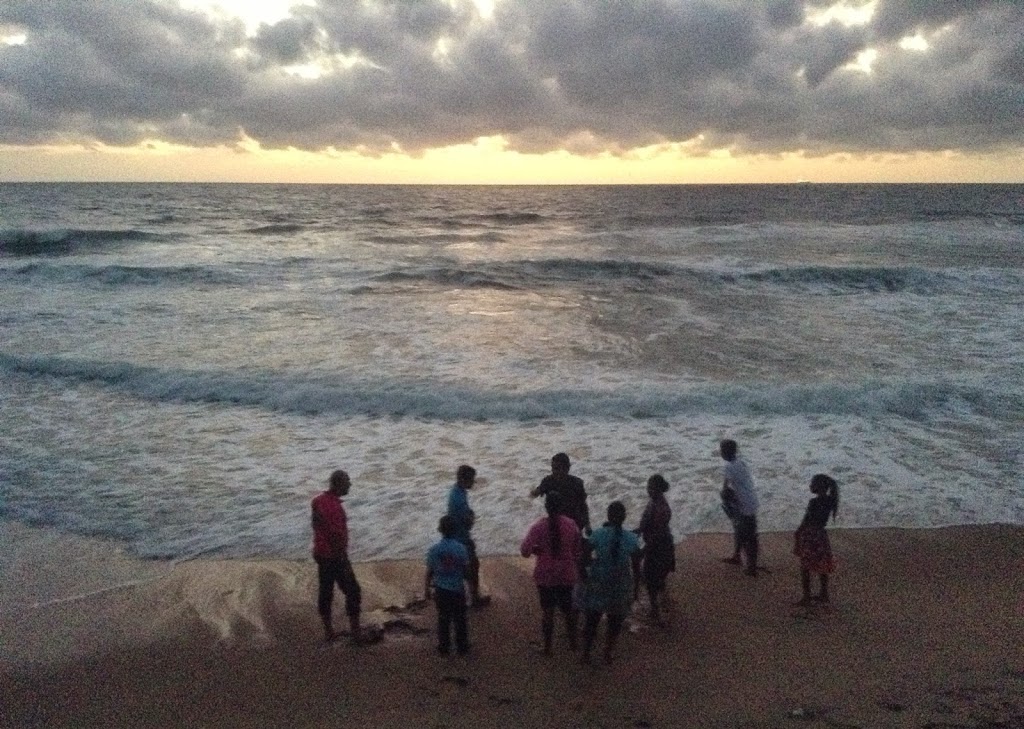 |
| Groups of families congregate at the water’s edge, enjoying the waves coming in and the sun slowly setting. |
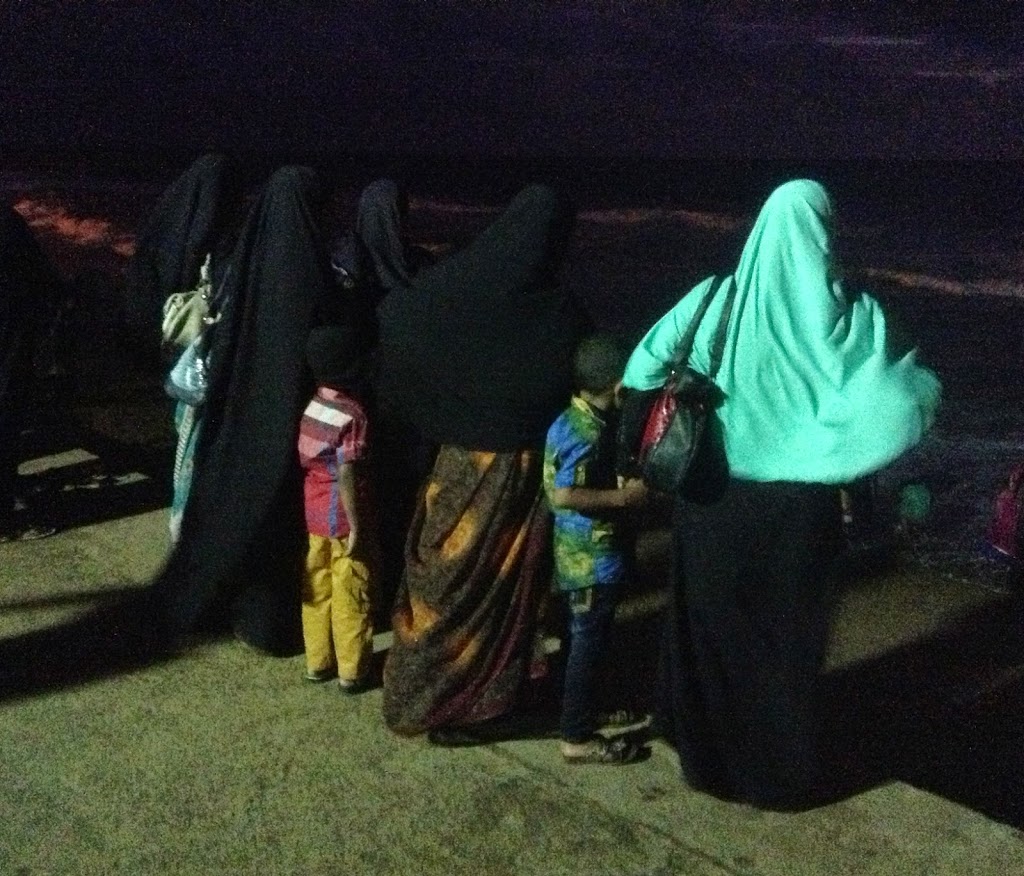 |
| Once the sun goes down, large flood lights allow for people to continue enjoying their evening at the water front. |
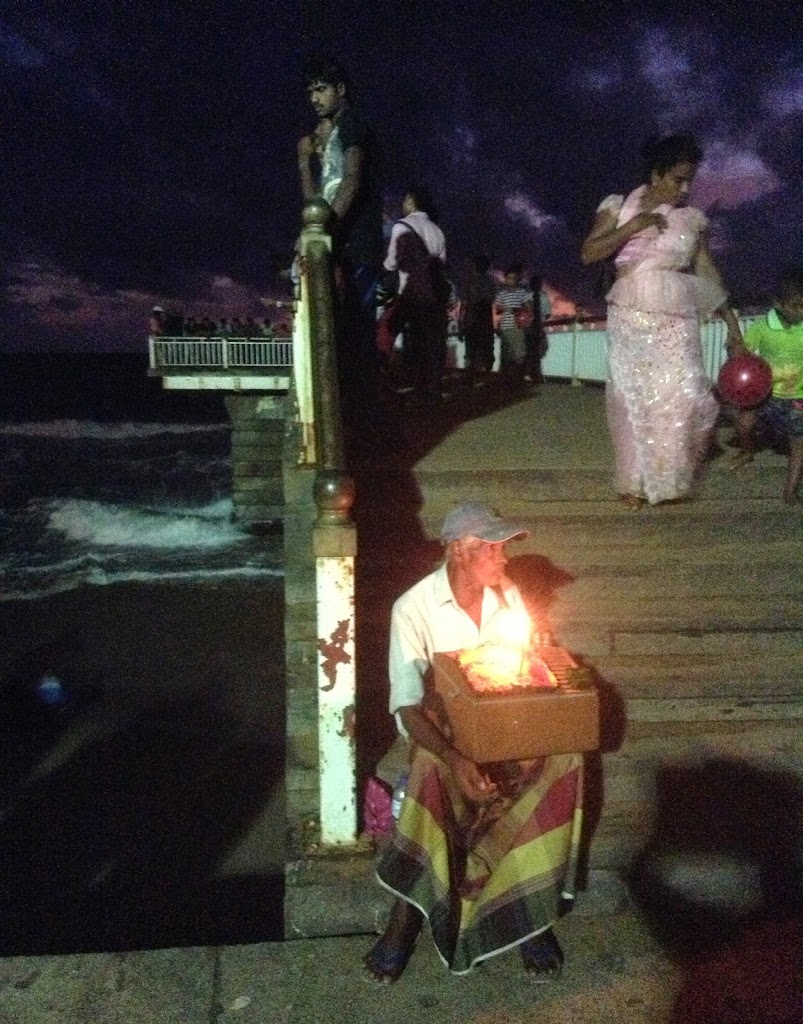 |
| A vendor at the entrance to the jetty, selling snacks. |
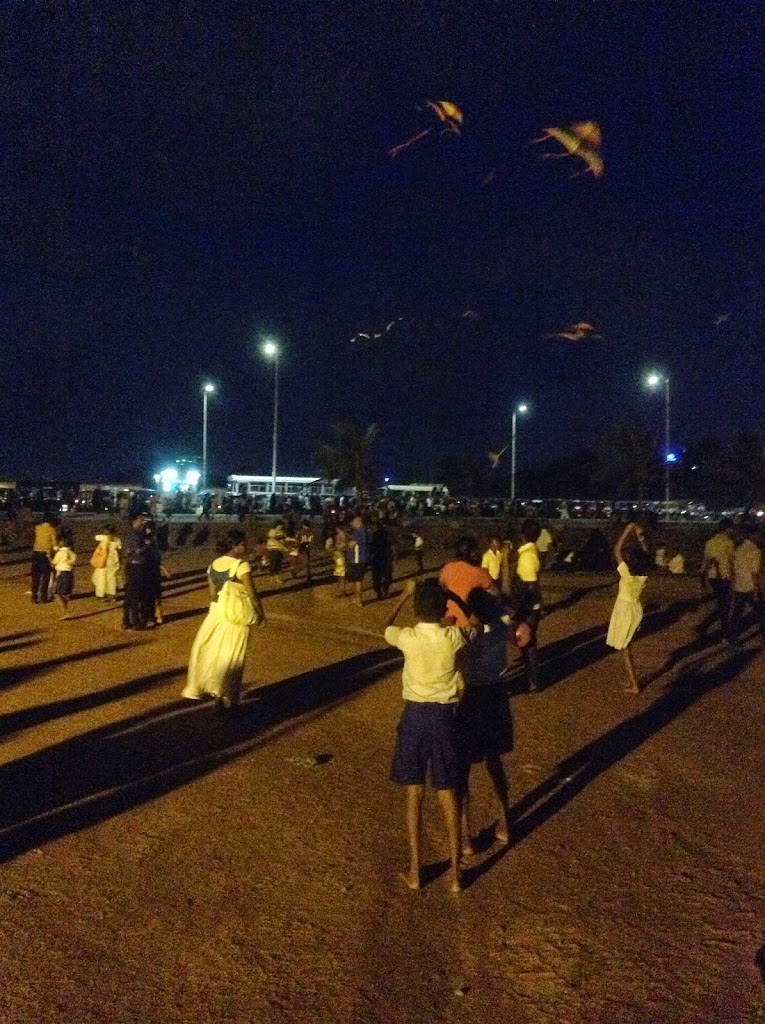 |
| Behind the promenade is a large area where children are flying kites in the evening breeze. |
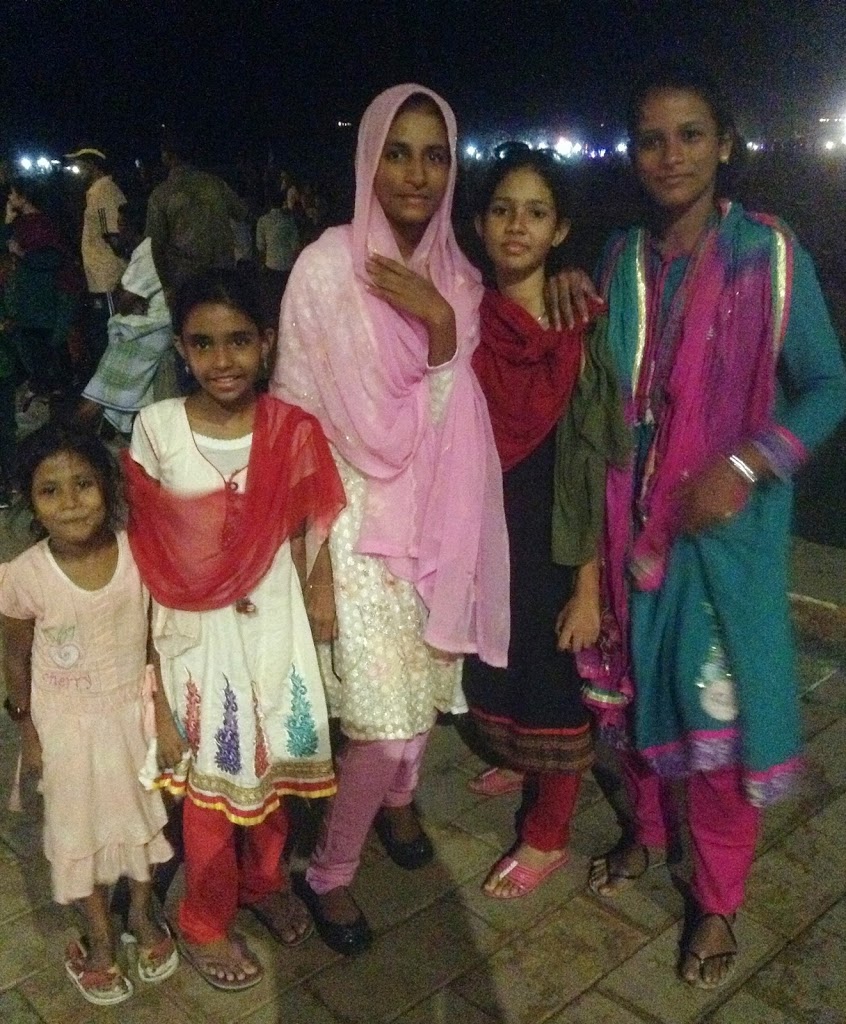 |
| We have the pleasure of meeting and spending time chatting with this Muslim family. They are in Colombo on a short vacation from their home town in the East of Sri Lanka. They have few opportunities to interact with foreigners and invite us to visit them at their home. |
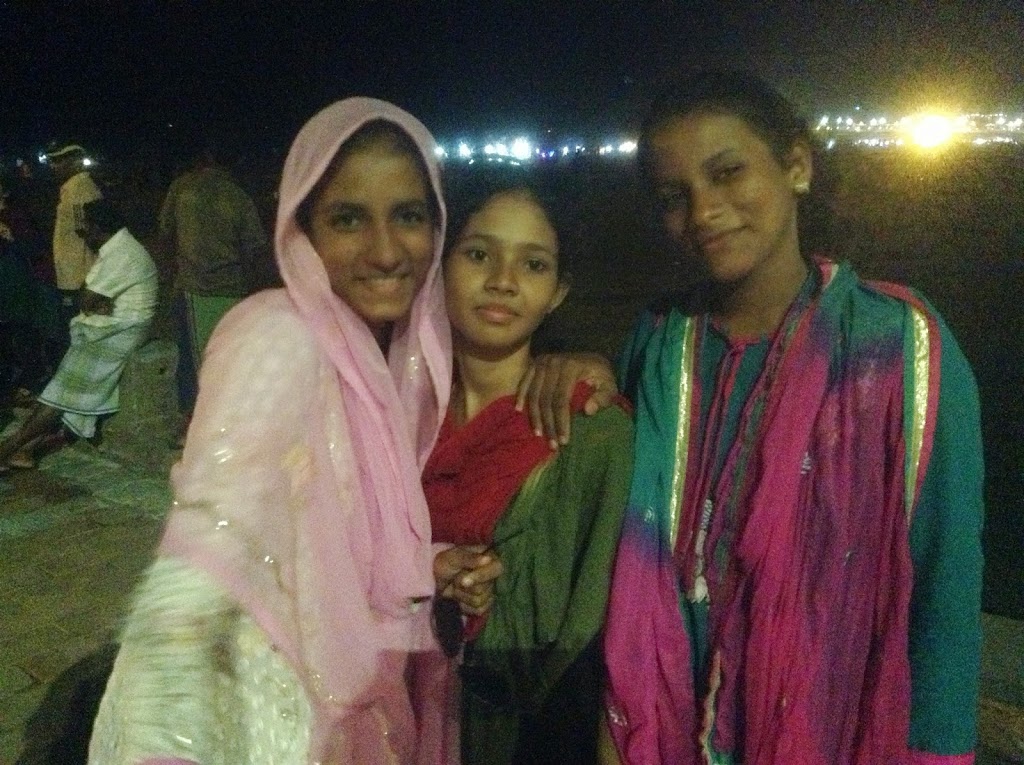 |
| The young women in the family are particularly friendly. “You are so very friendly” they tell us… We have the same feeling about them! |
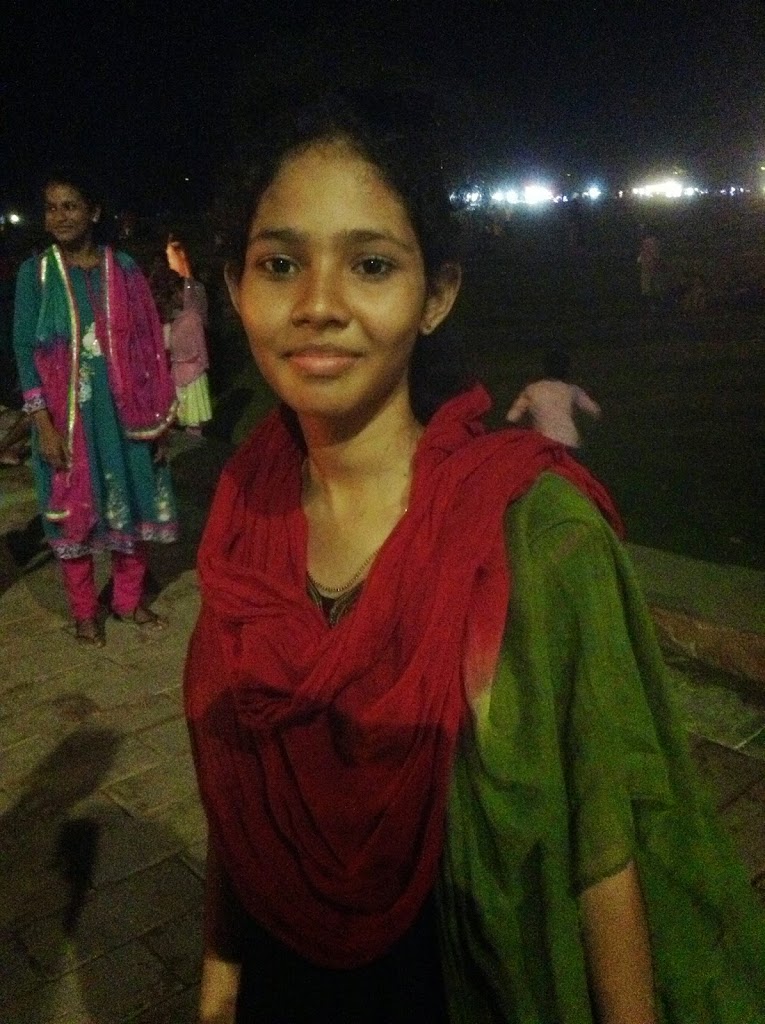 |
| 16 years old with excellent English, as that is the main focus of her studies. |
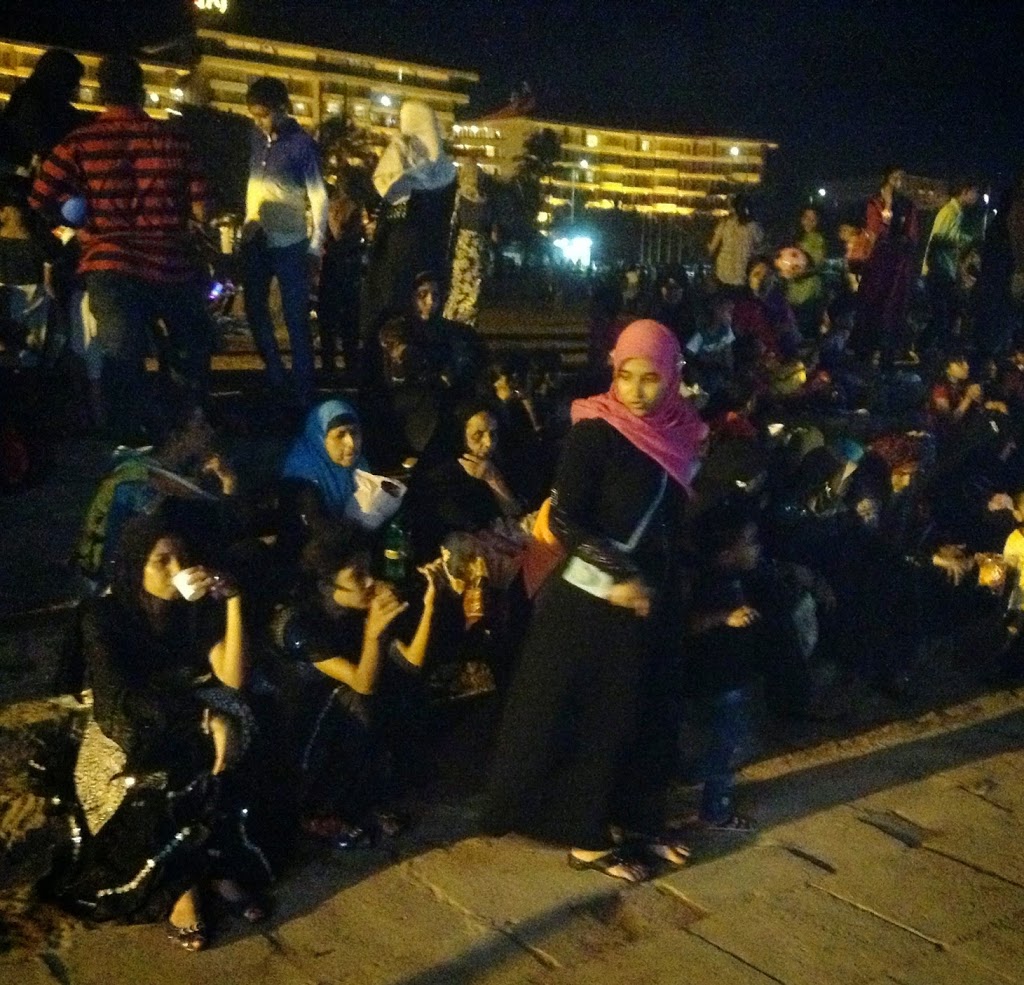 |
| Sri Lankan Muslim women dress reflect the full spectrum from moderate to conservative Islam in Sri Lanka. Some younger women wear jeans and a hijab (head covering) only, and others wear brightly covered saris, and others such as the women pictured here, are more conservative and are mostly in black. Note that their faces are uncovered, so there is still a more conservative look which is seen in the street with women showing only their eyes. |
A bit of history and political context for Sri Lanka:
Sri Lanka had a 35 year civil war which ended recently, in 2006. Over a three thousand year history, great global powers sought to control the fertile country for its spices and geographic location – starting with India, and more recently a succession of Colonial powers – first the Portuguese, then the Dutch and finally the British.
Finally, in 1948, Sri Lanka, then known as Ceylon, was able to wrest from Great Britain its independence, following closely India’s successful movement, led by Gandhi to shame the British Empire into abandoning its colonial claims in the South Asian sub continent.
The Civil War that engulfed Sri Lanka for over three decades was centered around a typical theme of a majority ethnic group, the Sinhalese, denying a minority group, the Tamils, a sufficient degree of independence.
The Tamils are the oldest remaining group of what were “ancient people” ~ a people that has managed to survive, for 3000 years, without its own territory, spread as it is between 4 countries – in India where the Tamil population represents 5% of the population, in Malaysia also 5%, in Singapore 3% and Sri Lanka, where the Tamil represent 15% of the population, mostly in the north of the country.
As a whole, the Tamil ethnic group has a population of 77 million, (i.e. more than France.) The Tamil “Tigers” as they are called, sought independence from the Sri Lankan Sinhalese majority, ultimately seeking to achieve this reality by force, and failed to achieve their goal until they were brutally crushed by the current Sri Lankan government.
Sri Lanka today finds itself in a complex geopolitical environment that has at least 4 protagonists (India, China, Japan and the U.S.). India, Sri Lanka’s most immediate neighbor is of course a natural partner. However China’s expansionist drive to reshape South Asia and secure maritime control over the region, is investing massively in Sri Lanka.
The attraction for China of having a vassal state with port access so near its strategic competitor India, makes it a primary target of opportunity for the Chinese.
The PRC has already invested in new roads, ports, energy plants and this is just the beginning. In fact while we are here Chinese Premier Xi is her too and in a marathon 23 hour visit, during which he is expected to sign 20 major investment contracts totaling nearly 2 billion dollars.
The US meanwhile is playing into China’s hands by couching its relationship with Sri Lanka through the prism of humans rights violations. The Sri Lankan government carried out a massive lethal blitz at the end of the civil war, killing over 40,000 Tamil “rebels” and civilians in its northern region.
What is playing out, therefore, is a race between China on one side and the U.S., India and Japan (acting as a proxy for the U.S.), to exert some measure of influence on the development of the country, hoping to secure long term diplomatic “friendship” (and financial indebtedness) by Sri Lanka.
In this game, China is way, way, way ahead.
Witness today’s newspaper headlines, welcoming Premier Xi who comes with a basket of infrastructure development programs to further expand China’s footprint in Sri Lanka, funded by long term, low cost economic development loans to the government of Sri Lanka.
























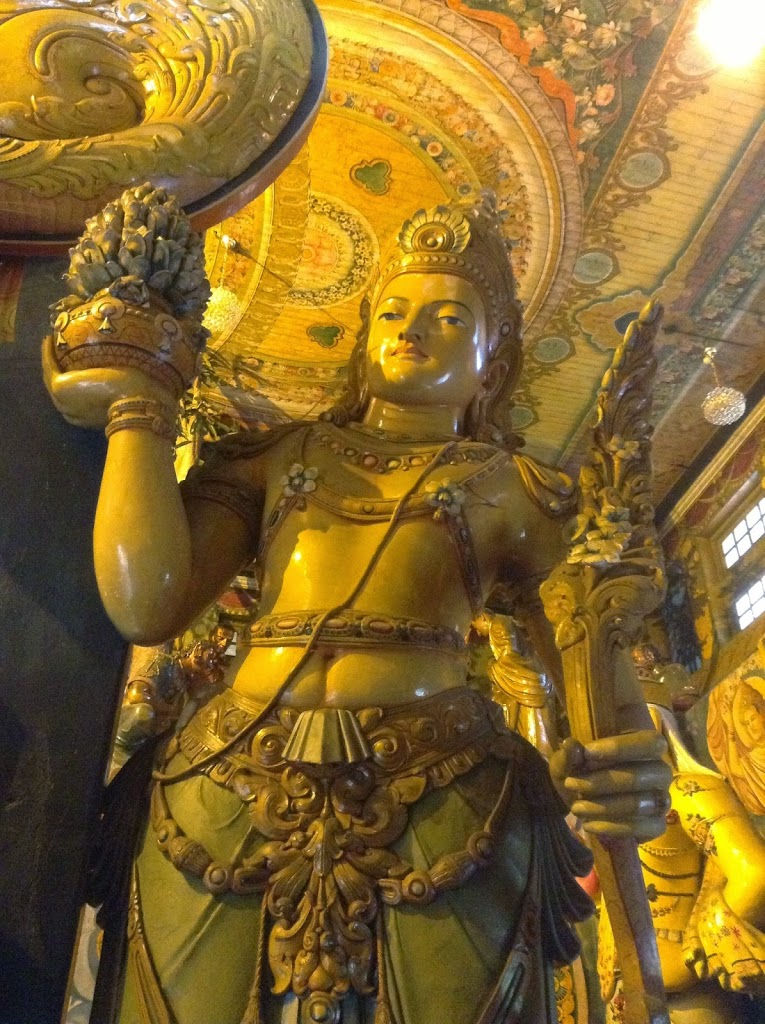
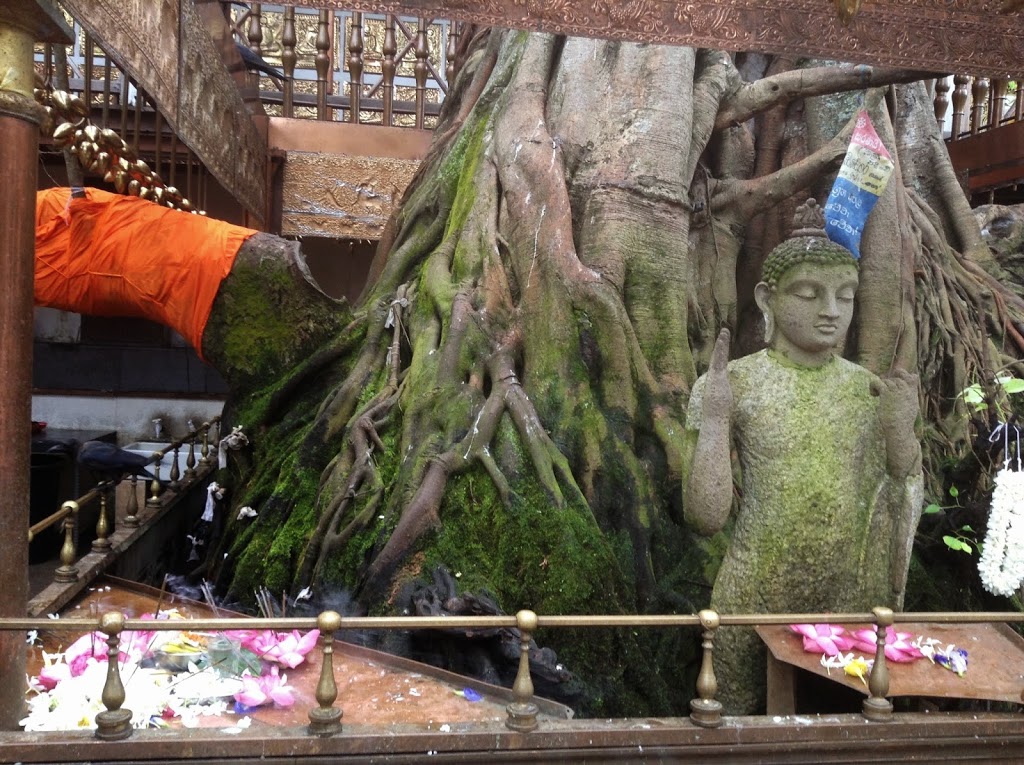

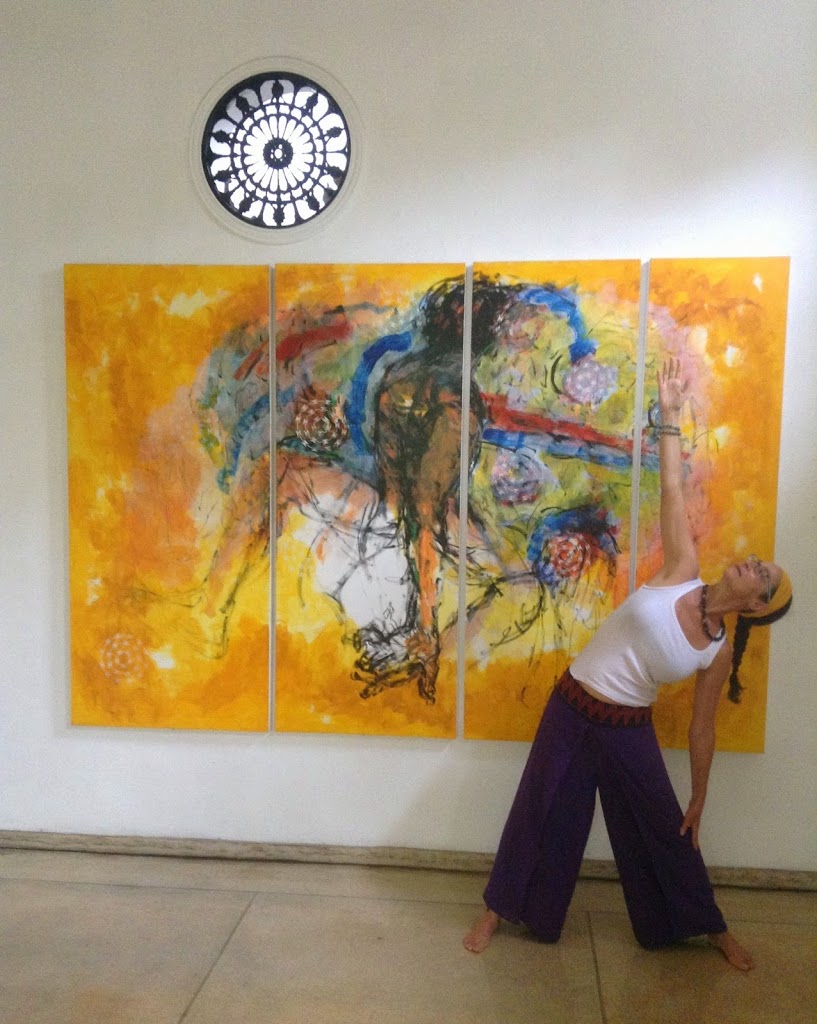
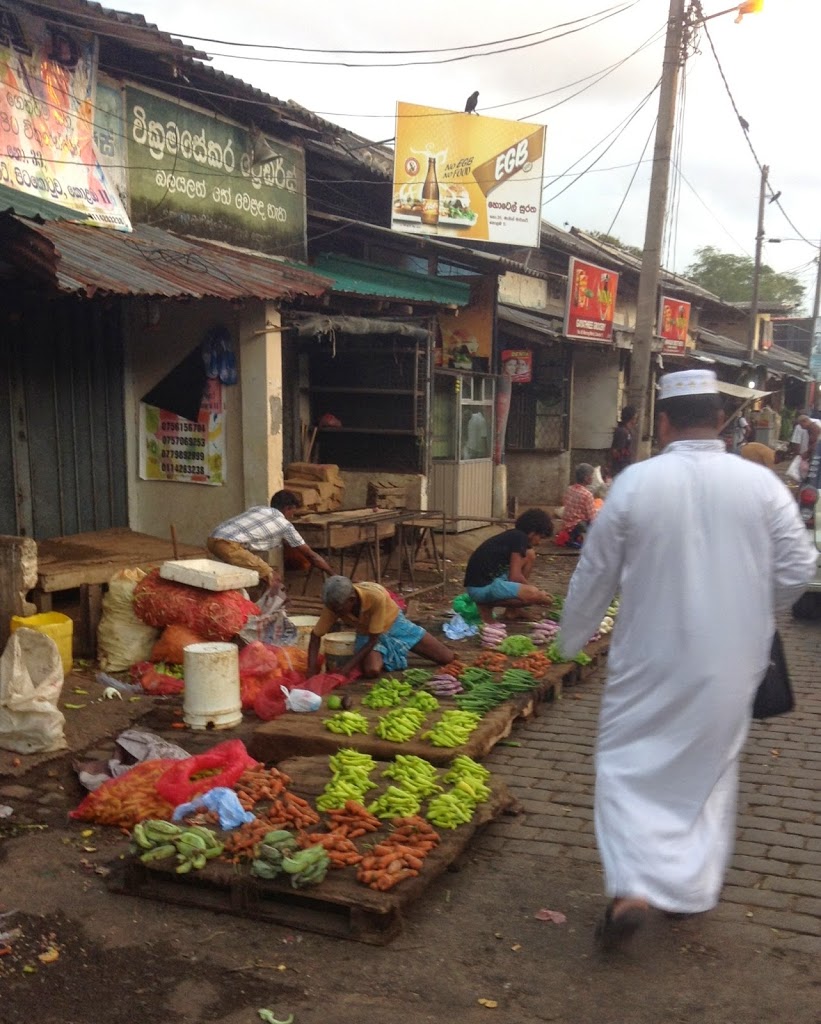



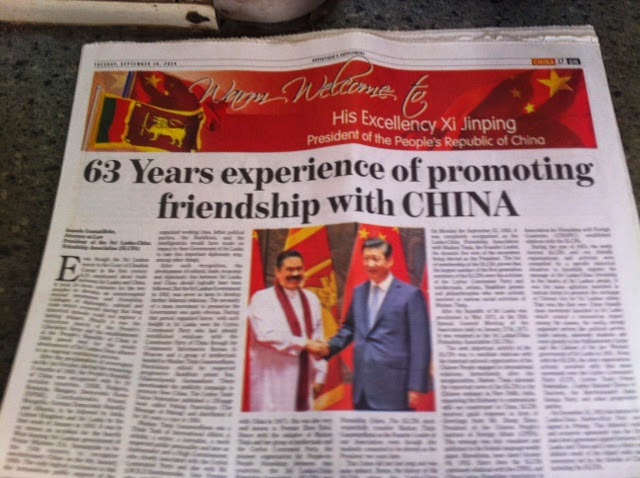
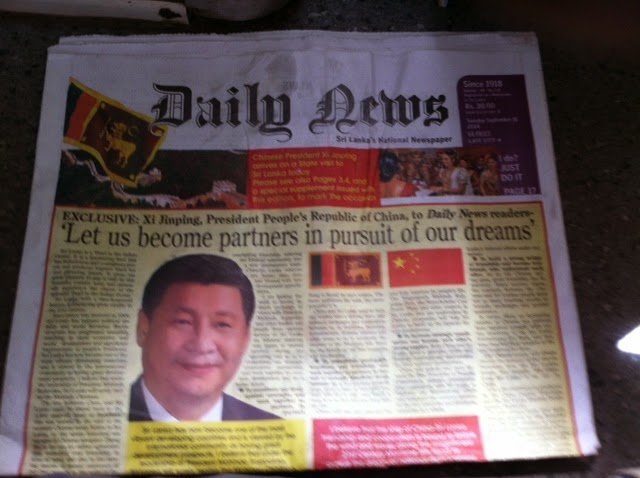
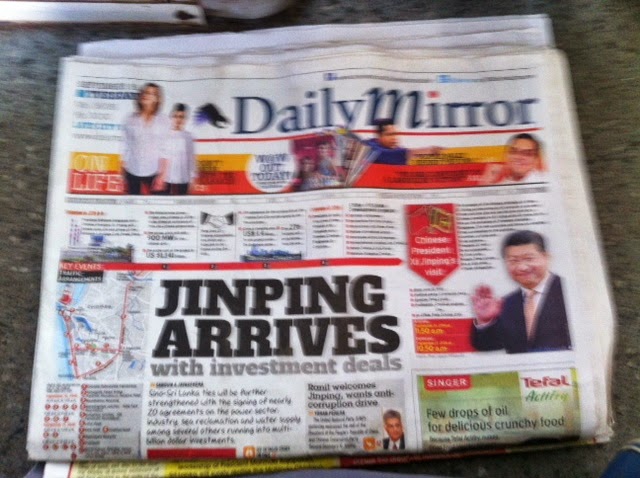
Sounds like a wondrous place! Where are you staying? Lucky you! Enjoy 🙂
We are very much enjoying it so far. All the more wondrous as we did not expect to be here! Staying at a small guesthouse in Colombo overlooking the train tracks and the ocean. Thanks!!